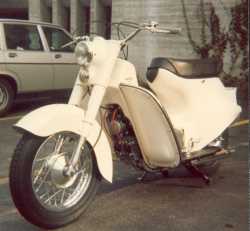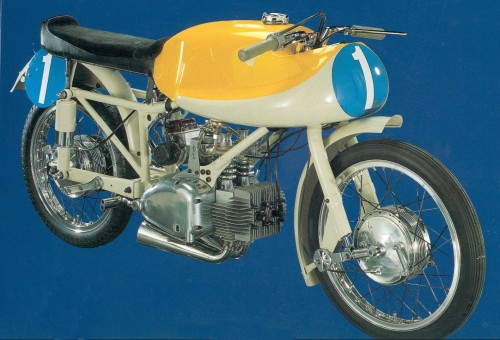




Scooters and Motorcycles
Scooters
Motorcycles

Home
History of Rumi
Scooter/Motorcycles
Technical
Gobbetto
The Squirrel
The Model "E"
Formichino with 8" wheels as standard
The Bold'Or with original racing bars
Formichino with 10" wheels
GT Granturisno 200cc (1956)
Junior Gentleman 125cc (1962)
Turismo 125cc (1950)
Sport 125cc (1952)
Regolarita 125cc (1952)
Junior Earles Sport 125cc (1956)
Bicarbuatore 125cc (1955)
Turismo 3 veloceta 125cc (1953)
Club events



Photo Gallery
For sale/wanted
Rumi Vienna

The Squirrel (Scoiattolo)
The Gobbetto first came into being during 1951 and was discontinued during 1955. The Gobbetto was designed purely for racing with a max speed of 136 km/h

The Rumi Bol D'or racer replica of the 24 hr Bol D'or time trials
Moto Rumi started scooter production during 1953/4 aiming at the Lambretta and Vespa market which by then had taken hold throughout Europe
First to appear was the Rumi Formichino manufactured in cast aluminium, which turned out to be rather expensive so Rumi started production of the cheaper Formichino E, commonly known as the Little Ant. The model E came with a steel tube frame with steel panels and mudguards.
The first scooter to appear in 1954 was made from cast alloy which had a single rear frame with an integral tool box in the side. This model was superseded in 1956 by the two part rear frame Formichino with a steel tube toolbox under the front saddle.
All of the scooter models came with a 125cc twin cylinder engine as used in the motorcycles but with lower power output.
The model E was not a major success so after a few hundred were made production was discontinued. The original cast aluminium Rumi was much more successful breaking into the French and UK markets in relatively large numbers.
Soon Rumis were seen in the major European countries, France, Belgium, Sweden, Switzerland and Austria and the UK.
The Rumis success in racing also helped sales. Major success came in winning the famed Bol d'or race in Monthlery three times in succession.
Rumi soon took advantage of this success by producing the twin carburettor version named the
Bol d'or which caught the eye of the more sportier rider..
The success of the Rumi scooter looked assured until Lambretta and Vespa started production
of their latest models. Lambretta Li150, TV175, GP200. Vespa GS150 and the later models
GS160 and 180.
These models took control in the early 60s pushing Rumi sales well into the background.
Unfortunately Rumi eventually went into liquidation and stopped production during 1960.
However, there was still a lot of interest in Rumis in the UK and Austin's in Harlesdon had
a number in store and kept sales going. Stephens Scooter Mart in Richmond bought many
parts from Austin's and also helped Rumis to remain until 1965 when even these outlets
started to fail due to lack of support from Rumi. Spares became short so eventually production of new Rumis stopped.
There are approx 60 Rumis left in the UK now. Many of them broken up and in boxes but we
still have 40 or so running.
The revolutionary 4 stroke V 98/125/175cc
never going into production
The "E" model was Rumi's economy
scooter costing less than the aluminium version. Rumi soon stopped production
through lack of sales.
The Formchino started
life with 8" inch wheels
as shown. Later Rumi
introduced 10" wheels
on the Sport model
The caburettor fitted to
the standard Formichino
it is an 15mm Dellorto
AU15.
Twin 18mm Dellorto's as fitted to
the Bold d'Or
The 22mm MB22 Dellorto fitted to
the Tipo (Type) Sport
Rumi Started their transport business with motorcycles, Rumi produced many models as shown below. Some were raced in road races while others were used on dirt tracks and Scrambling known today as Moto Cross.
The motorcycles were successfully raced troughout Italy during the mid to late 1950s. Unfortunately the motorcycles did not make a huge mark in the UK market. Very few of the machines exist in the UK today. The most common model to be seen was the Junior Gentleman and the Sport. The latter was often stripped for road racing.
The history of the Rumi motorcycle is full of history and intrigue










